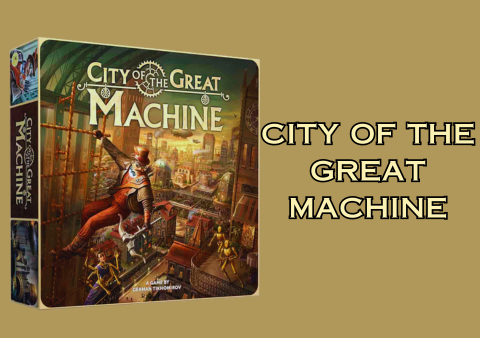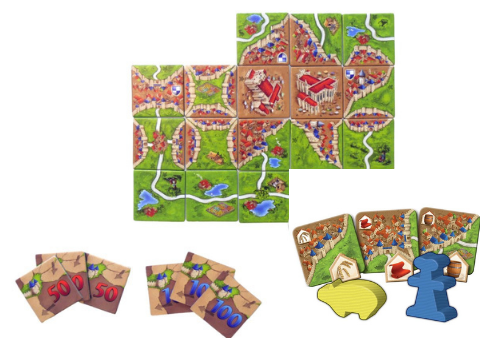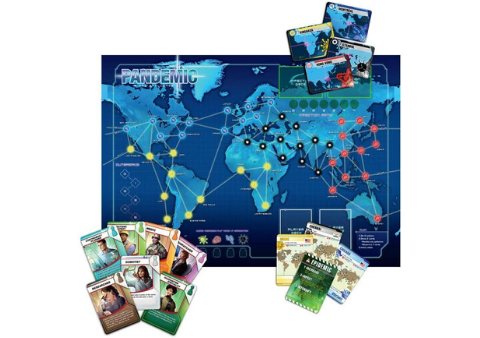Have you ever tried the work of a goldsmith? It's not always easy to get to the treasure of your dreams. Especially when diversionary criminals are always trying to get in the way and grab all the riches themselves. Strategic Saboteur allows you to play as either a gold digger or a saboteur. From the start of the game, nobody knows the specific profession of each player.

Game set
- 44 wildcards;
- 27 action cards;
- 28 gold nugget cards;
- 7 Goldsmiths' cards;
- 4 diversion cards.
Frequently asked questions
❓ How many people can play Saboteur?
This game can be played from 3 to 10 people.
❓ From what age can I play Saboteur?
Recommended to play this game For people aged 8 and over.
❓ How long does it take to play Saboteur?
Under the original rules, the game is expected to last about 30 minutes. Although the time may vary each time you play. It all depends on how quickly the players act.
Preparing for the game
All the different types of playing cards are separated.
The number of people playing determines how many Goldilocks and Diversion cards we use. The other cards are placed in the game box.
| Number of players | Number of Diversant cards | Quantity of Goldilocks cards |
|---|---|---|
| 3 | 1 | 3 |
| 4 | 1 | 4 |
| 5 | 2 | 4 |
| 6 | 2 | 5 |
| 7 | 3 | 5 |
| 8 | 3 | 6 |
| 9 | 3 | 7 |
| 10 | 4 | 7 |
The Goldsmiths' and Diversions' cards are placed in a single pile and shuffled. Each player receives one card to play with. When a card is received, the player must look at it and place it face down next to him or her so that other people cannot see the dwarf. The card that is left undealt should be put aside until the end of the Saboteur game. Do not look at what is depicted there.
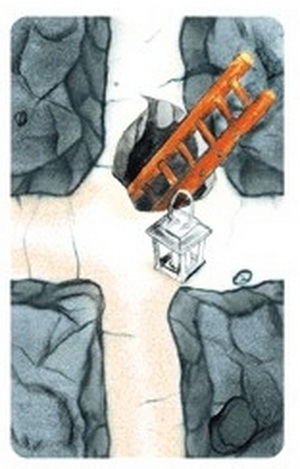
The card representing the ladder is the starting card. There are three end cards in total. One of them shows a treasure and the other two show a stone. The end cards are shuffled and placed on the table with the starting card as shown below See for example.
The game will require you to create paths that connect the starting and ending cards. The paths can be straight, circular, etc. They can stick out behind See for example the limits specified.
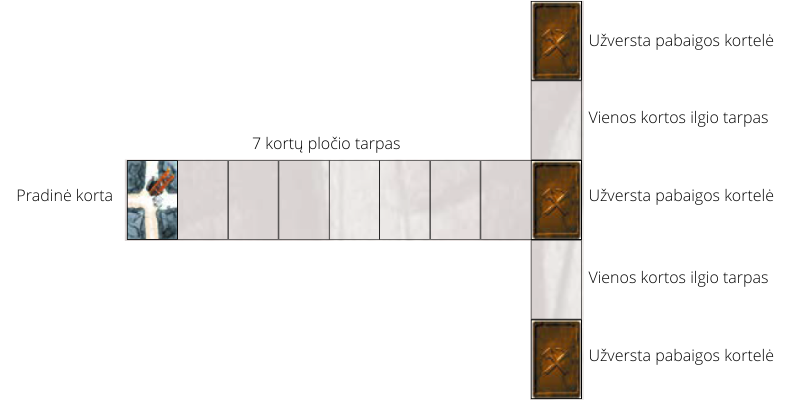
The remaining path and action cards are placed in a single pile, shuffled and dealt to the players. The number of cards each person receives depends on the number of people playing.
| Number of players | Number of path and action cards per player |
|---|---|
| 3-5 | 6 |
| 6-7 | 5 |
| 8-10 | 4 |
The remaining cards are placed in a pile of unused cards in a way that is accessible to all players.
The gold nugget cards are shuffled and placed next to a dwarf card that does not belong to anyone.
The starting player can be selected by mutual agreement.
Saboteur rules
Saboteur game starts
At the start of each turn, players use one of their cards. It can do one of the following:
- a path card is included with the maze;
- use an action card;
- the face-down card is placed on top of the used card pile.
When the desired action is taken, the top 1 card is taken from the top of the unused pile. This action ends the player's turn.
Note: Once a stack of unused cards has expired, the stack of used cards cannot be withdrawn. Then only cards still in hand are used.
Use of the Road Card
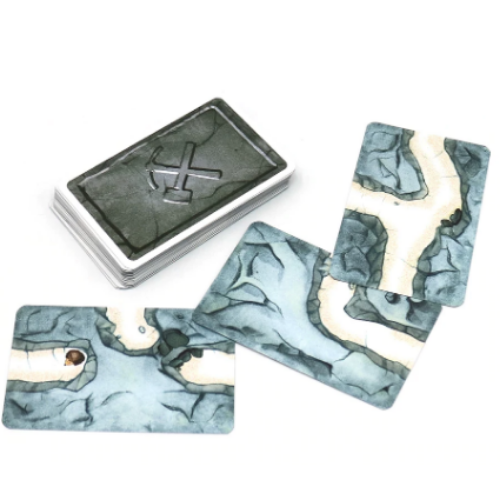
These cards allow the dwarves to travel from the starting card to the ending card. A path card can only be added to a card that has already been placed. It cannot be placed "in the air" or attached to end cards. The path is formed only from the starting card. Cards can only be placed upright. They can only be contiguous with each other on their respective edges.
Goldsmiths try to make the path from the start to the end cards as fast as possible. The job of the Diversioners is to hinder the Gold Diggers. It is important not to pretend that they are in the way. Diversioners must pursue their goal as unobtrusively as possible.
Using an Action Card
Action cards must be placed face-up in front of yourself or another player.
Card options:
- hinder or help others;
- remove one card from the road maze;
- get information about end cards.
Broken tool cards
As long as at least one such card is placed in front of a player, that player may not use any road cards. The other cards can be used. No more than 3 broken tool cards (only one card of a different type) may be placed in front of a player at any one time. Only when there are no more such cards in front of a player may he use the road cards again.
Tool repair cards
They remove 1 of broken tool cardsthat are placed in front of a player. These cards can be used to repair tools placed in front of any player (not necessarily only personal tools). After repairing a tool, both cards (the broken and the repairing card) are turned over and placed in the used card pile. It is important to remember that only the type of tool concerned can be repaired. For example, a pick can only be repaired with a pick.
If a correction card is used on which two objects are shown, then it is possible to selectively correct one of these objects. But only one at a time, not both.
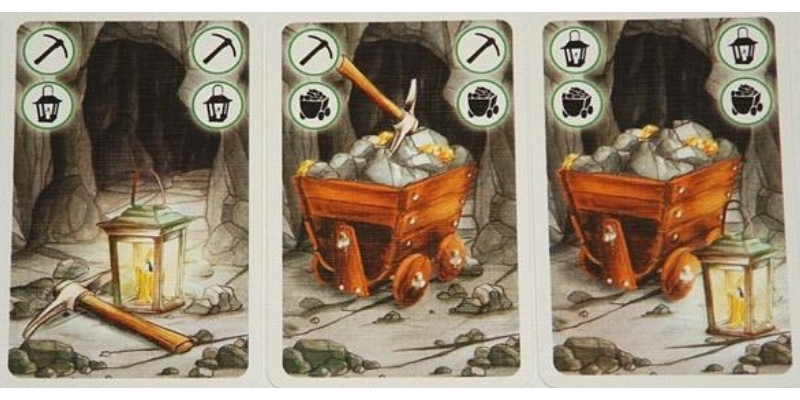
Note: Mending cards can only be used when there is something to mend (a broken tool card placed face up in front of at least one player).
Rockfall card
This card is placed in front of you. The player holding the card can then remove one of any a road map. Exceptions: start and end cards. The Rockfall card is useful for both the Goldsmith (it can remove a deadlock) and the Diverter (it can make a gap in the path leading to the end card).
You can only continue your journey at locations that are connected to the original card. Therefore, only the following actions are possible after the stones have fallen:
- continuing on another branch of the road;
- the appropriate card is placed at the site of the collapse, thus restoring the interrupted path.
Card providing information on back cards
When a player uses a back card inspection card, he takes one of the three back cards and examines it carefully by himself alone (not to be shown to others). After examining the card, he/she turns it over again and puts it back in its place. The used back card information card shall be placed in the used card pile. The advantage of using this card is that the player who has used it knows whether it is worthwhile to build a path to the back card that has been inspected.
Card discard
When a player is unable or unwilling to use a card, they can simply place it in the used card pile. It is important not to show others what is depicted there.
End of round
When the end card is reached in a continuous path after the use of a path card, the end card is turned over.
- When the card represents a treasure, the round is over;
- If the card contains a stone, the round continues.
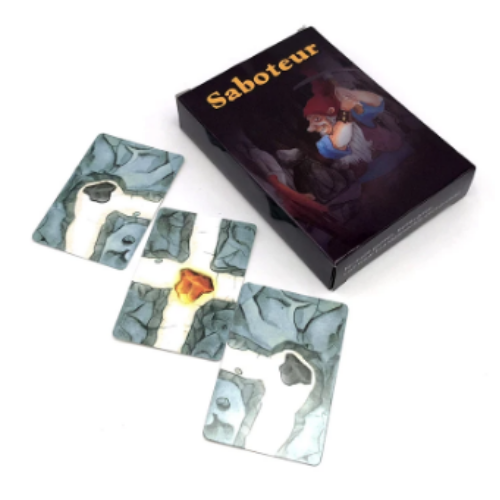
The open end card must be placed in its previous position so that its paths match the paths of the cards already placed. If this is not possible, then the player who placed the last path card shall place the end card wherever he wishes. If a player decides to place a card between the other two end cards and creates a continuous path to them, then the other two end cards are also turned over.
If there are no more playing cards in hand and the unused stack is exhausted, then the round must be completed without reaching the end cards.
Gold distribution
Gold Diggers win when an uninterrupted path is created from the starting card to the end card representing the treasure.
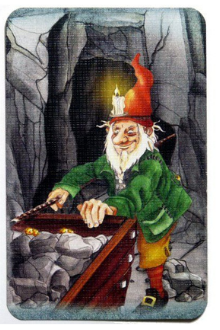
The player who reaches the treasure card takes as many gold nuggets as there are people playing. He then looks at all the cards and chooses the one he thinks is the most valuable. He then sends the gold nuggets counterclockwise to the next gold digger. He also picks a card and sends the rest on. This continues until the last gold bar is taken.
Note: When 10 people are playing, only 9 gold bar cards are drawn.
When 3 or 4 people are playing (in which case a diversionary player is not always involved), no gold nuggets are distributed if the treasure card is not reached.
Diversants win when gold diggers fail to reach the back treasure card. Distribution of gold nuggets to diversions:
| Number of players who have played in the diversion | Amount of gold nuggets that can be taken by each diverter |
|---|---|
| 1 | 4 |
| 2-3 | 3 |
| 4 | 2 |
Note: Divers are given a specific number of gold nuggets. If he owns 4, he receives 4 gold nuggets, but not 4 nugget cards.

The diversion player takes 1 card from the top of the pile to get the appropriate amount of gold nuggets. The player draws cards until he/she has collected the required amount. If, after drawing a card, the player has too many nuggets, then the last card drawn must be turned over and placed at the bottom of the pile. Repeat the process until the required number of nuggets is collected. The other diversants do the same.
You may not show your Gold Nugget cards to other players until the Saboteur game is completed.
Start of a new round
Once the gold has been shared, a new round begins. The Dwarf cards are shuffled (the card set aside in the previous round is also used). Action and Path cards are dealt. This is done in the same way as in the first round. The only exception is that players have already accumulated gold nugget cards. The remaining gold nuggets are put aside. The player to the left of the person who started the first round starts the round.
Saboteur game ends
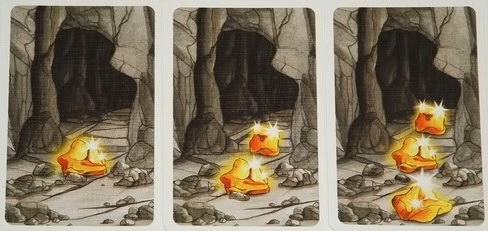
After three rounds, Game ends. All gold nuggets that appear on the accumulated gold nugget cards are counted. The winner is the one with the most nuggets. If several players have the same number of nuggets, they are all declared winners.
